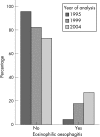Rapidly increasing prevalence of eosinophilic oesophagitis in Western Australia
- PMID: 16877474
- PMCID: PMC2083004
- DOI: 10.1136/adc.2006.100974
Rapidly increasing prevalence of eosinophilic oesophagitis in Western Australia
Abstract
Aim: To assess the prevalence of eosinophilic oesophagitis in a tertiary paediatric gastroenterology clinic population.
Methods: A retrospective audit of Western Australian children investigated for oesophageal disease by paediatric gastroenterologists in the years 1995, 1999 and 2004. Macroscopic appearance of the oesophagus at endoscopy, original histological findings and diagnosis were recorded for each child. Biopsy specimens were blindly re-evaluated, with re-coded histological diagnoses compared with original reports. Age, sex and socioeconomic status were identified for each child.
Results: The prevalence of eosinophilic oesophagitis in Western Australia increased over the decade 1995-2004, rising from 0.05 to 0.89 per 10 000 children, with a concomitant increase in the severity of oesophagitis as determined by inflammatory cell numbers and associated features of inflammation. Children diagnosed with eosinophilic oesophagitis had a median age of 78.9 months (6.58 years), with no associated predisposition by sex or socioeconomic status trend. Almost one third of cases were macroscopically normal at endoscopy. All children with an original diagnosis of eosinophilic oesophagitis had > or =40 eosinophils per high-power field.
Conclusion: Over the decade 1995-2004, a true increase was seen in the prevalence of eosinophilic oesophagitis, not accounted for by diagnostic shift. Histological samples should be taken at endoscopy to confirm or exclude the diagnosis of eosinophilic oesophagitis.
Conflict of interest statement
Competing interests: None declared.
References
MeSH terms
LinkOut - more resources
Full Text Sources
Other Literature Sources
Medical


